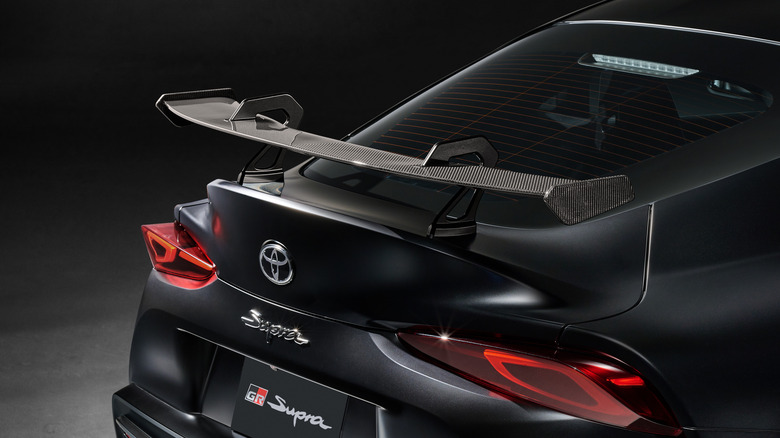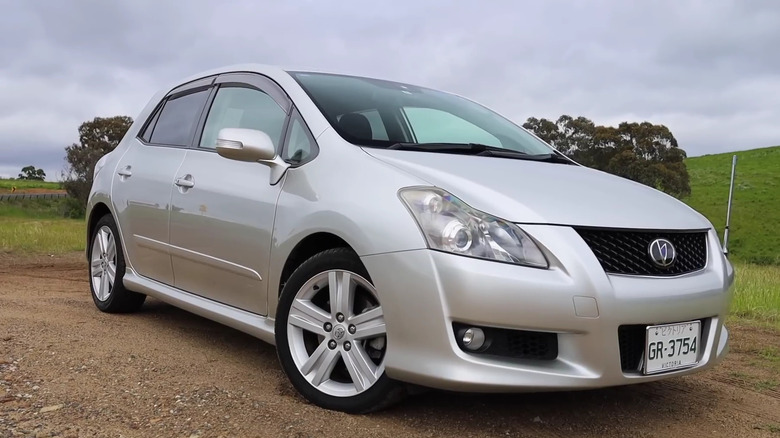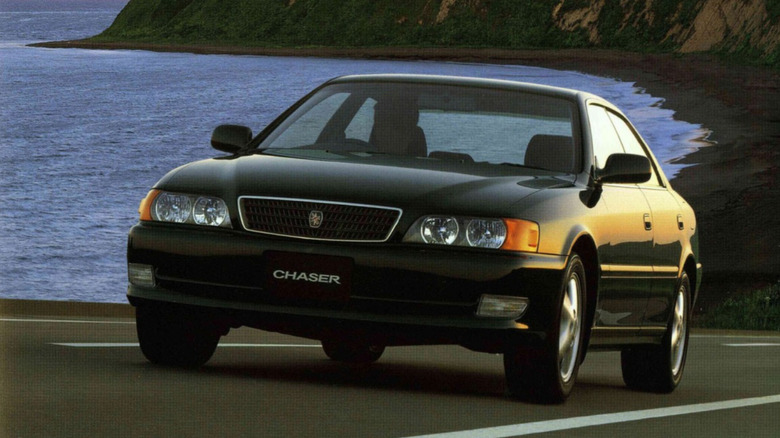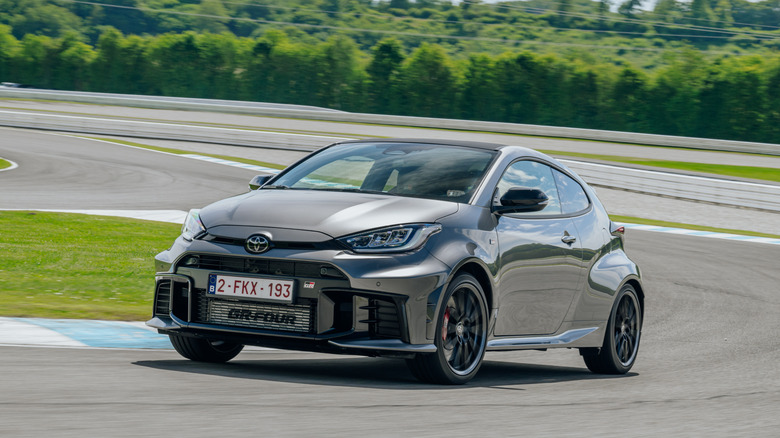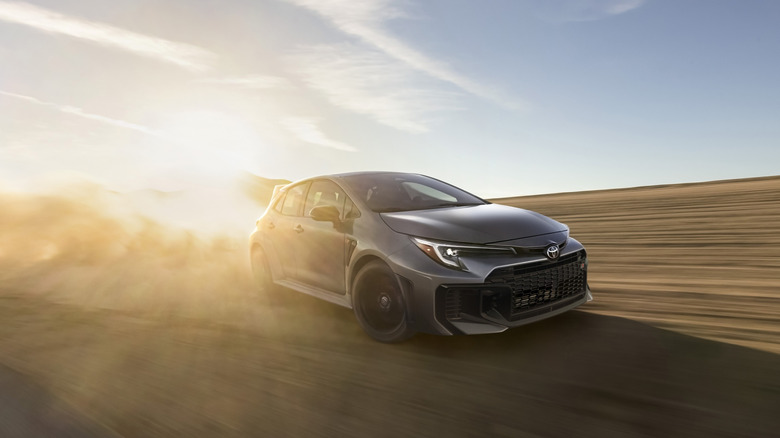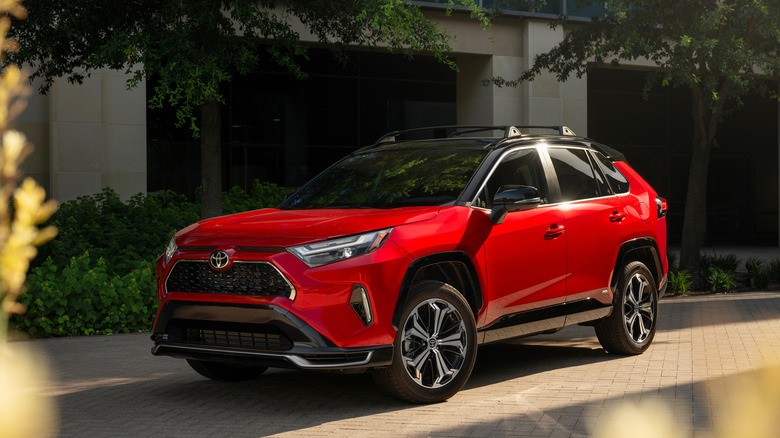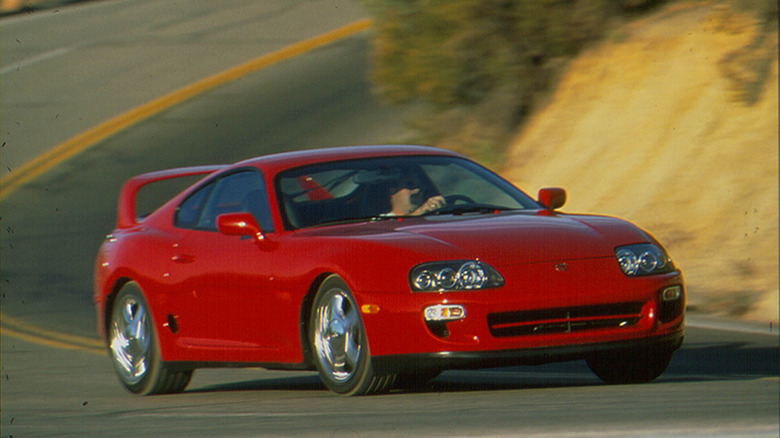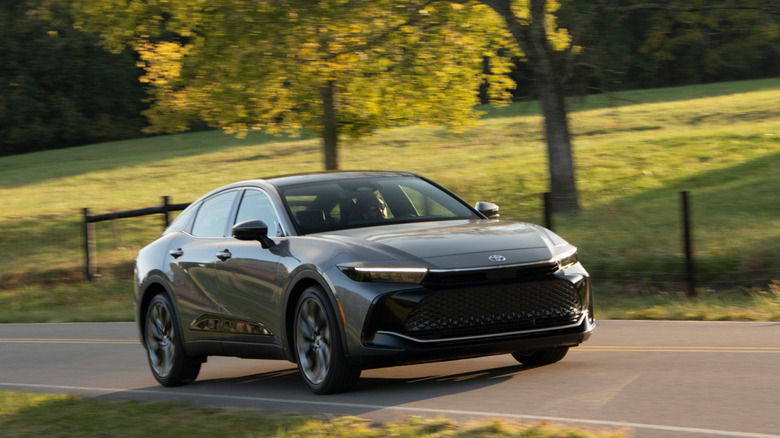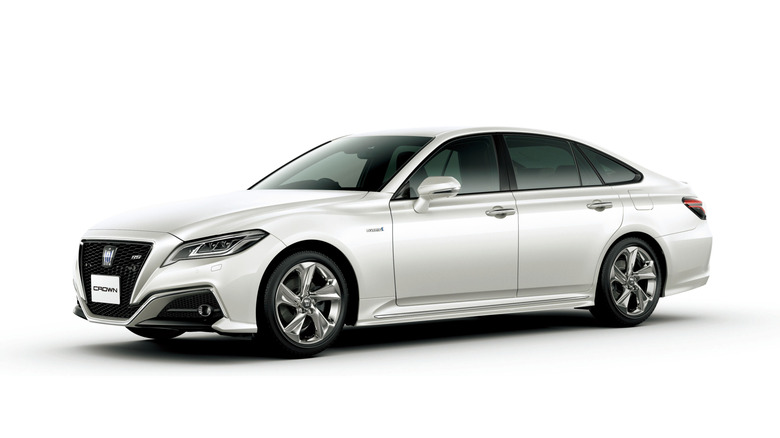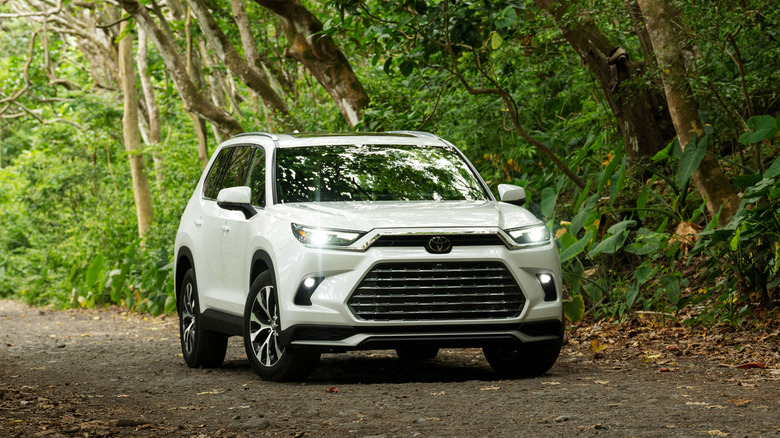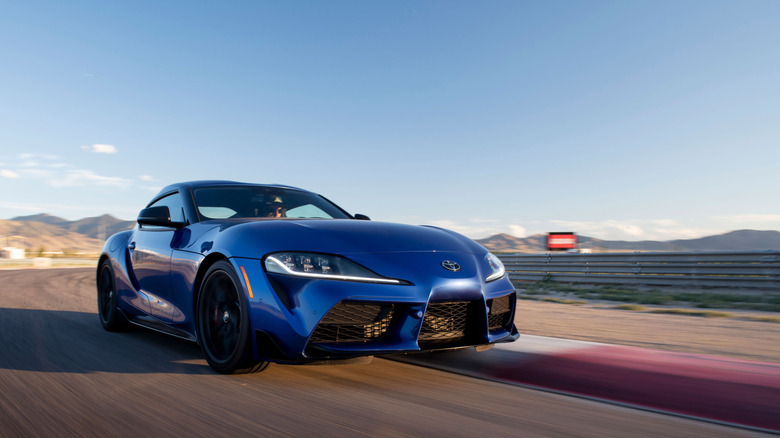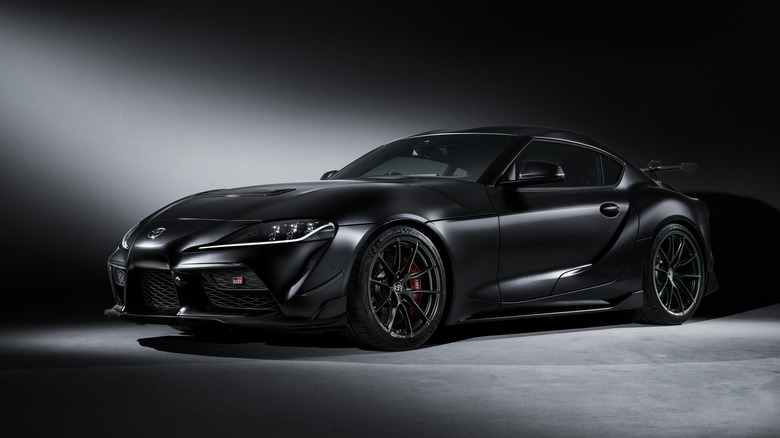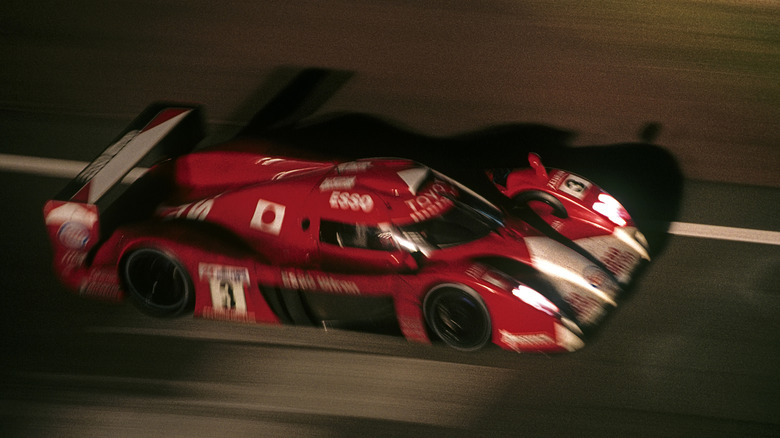12 Of The Most Powerful Toyota Cars Ever Built
Toyota's cars have always been synonymous with reliability, practicality, and ease of use. To put it bluntly, the brand is seen as the safe choice by many drivers around the world— maybe even a boring one. However, while the Japanese brand never fought the horsepower wars, it has produced some potent machines in its successful history.
Toyota has quite a few engines in its portfolio, including twin-turbocharged monsters, roaring V8s, and even a V12. Don't forget about the hybrids, too, because recently they have also added some necessary verve to the company's economy-oriented range. The list of powerful Toyota models is growing by the day, with the latest GR Supra Final Edition breaking the 400-hp barrier.
But what are the other most powerful Toyota cars ever built? Has the Japanese giant ever produced Ferrari-rivaling horsepower numbers? Lets tackle these questions, and give you the details on some interesting and powerful Toyota cars.
2006-2012: Toyota Blade Master G (276 hp)
The 10th-generation Toyota Corolla was one of the most forgettable, with no interesting sporty versions to appeal to enthusiasts. However, a version of Toyota's bread-and-butter model had all the ingredients to make a splash. It had a sharp-looking hatchback body based on the European Auris (also a Corolla with a different name) and a 3.5-liter V6 engine under the bonnet — yup, double the cylinders of a GR Corolla!
The Blade Master G was one of the wildest Corollas ever made. With the V6 borrowed from the Camry and several Lexus models, this hot hatch had an advertised 276 smooth horsepower and 254 lb-ft of torque at its disposal. The real figure was probably higher, as in 2006 the gentleman's agreement between Japanese automakers to limit all their models to 276 hp was still valid.
We'll have to shatter your dreams of a near-300 hp V6 Toyota hot hatch with two unfortunate facts, though; the Blade Master G was front-wheel drive only and had a six-speed automatic. Front wheel spin was thus an everlasting presence, and the fun-to-drive aspect was diminished with the lack of a manual. The Blade Master G still reached 60 mph in 5.8 seconds, but it was more of a luxurious hatch, rather than a hot one.
1996-2001: Toyota Chaser Tourer V (276 hp)
A sleek sedan body. A twin-turbocharged inline-six engine. Rear-wheel drive with a factory-installed limited-slip differential. This may sound like a BMW, but it's actually a legendary 1990s Toyota — the Chaser Tourer V. This JDM-only machine is called the Supra sedan, and rightfully so, as under the bonnet it features the 1JZ-GTE — the smaller, but equally good variant of the fabled 2JZ-GTE.
In the Chaser Tourer V, the 2.5-liter twin-turbo unit made 276 hp and 278 lb-ft of torque, but you can tune it to your heart's content and extract much higher figures, reliably. Oh, and you also get to play with a five-speed manual — the right transmission for a performance sedan. Change those gears quickly, and you'll be reaching 60 mph in a tad over 5 seconds. Quick, even by today's standards.
Toyota also wasn't playing around with the chassis. The Chaser Tourer V proved to be a very sharp handling machine, with excellent chassis balance. No wonder this JDM super-sedan became a darling in the drifting community, where its potent engine and good handling at the limit still give it an edge on the track. Meanwhile, the Chaser Tourer V would also work great as a daily driver. Space in both seating rows is excellent, and the trunk is huge, too.
2020-Present: Toyota GR Yaris (276 hp)
Remember rally homologation specials? They were quite the rage a few decades ago, with cars like the Lancia Delta HF Integrale and Mitsubishi Lancer Evolution probably still gracing young people's bedroom walls. But a modern rally homologation special has already secured its place in the pantheon of greats, and the Toyota GR Yaris might be even wilder than those legends.
This is no ordinary Yaris. It shares the front subframe with Toyota's city car, but borrows the rear subframe from the Corolla. Gazoo Racing, the team that also brought us the affordable Toyota GR86 fun machine, deleted the rear doors and even cut the roof by an astonishing 1.8 inches. Heck, the GR Yaris has a factory widebody kit that extends the track by 2.4 inches. It's way stiffer than the regular Yaris, too.
Still, these are only the sprinkles on top of what makes the GR Yaris' story interesting. The star attraction hides under the bonnet: a 1.6-liter turbocharged three-cylinder engine that produces a cool 276 hp (2024 model) and 288 lb-ft of torque, with a 0-62 mph time of 5.2 seconds and a grin-inducing six-speed manual. A less fun eight-speed automatic is also available, but most will choose the manual.
Crucially, all that three-cylinder goodness goes to the GR-FOUR AWD system that automatically adjusts torque splits in milliseconds to give you an outstanding grip. And it's agile, too, weighing just 2,822 pounds. Although it's not the most powerful Toyota car ever, it might be the most exhilarating one.
2022-Present: Toyota GR Corolla (300 hp)
The GR Yaris reached an almost mythical status in its short stint, but North American buyers could never get one. Fortunately, Toyota showed full commitment to its Gazoo Racing department with the launch of the GR Corolla.
More practical than its sibling, and even more powerful, the Toyota GR Corolla is the new standard for hot hatches. It's super fun to drive, with exceptional handling characteristics, and a six-speed manual in an era when automatics have already taken over. Toyota added the Yaris' eight-speed automatic for the 2025 model year, which should be faster overall. Still, we think you should be buying the GR Corolla to have fun — not to win races. The manual even blips the throttle on downshifts
Your smile won't fade when driving the GR Corolla. The stick shift is tactile. The steering is responsive and direct. The 1.6-liter turbocharged three-cylinder will centrifuge your internal organs with 300 hp and 295 lb-ft of torque. It's not as quick as an EV, but a 0-60 time of 4.9 seconds is nothing to scoff at. It just proves that three-cylinder engines can still be sporty.
Yet the rally-derived GR-FOUR AWD drivetrain with front and rear Torsen limited-slip differentials again steals the show here. For 2025, Toyota upgraded the system and now in Track mode, it varies the torque distribution from 60:40 to 30:70 to give you maximum grip on corner entry and exit, and there's even a 50:50 Gravel option for sliding around safely on dirt roads.
2020-Present: Toyota RAV4 PHEV/Prime (302 hp)
Gazoo Racing's performance cars are truly something else, but if you wanted a fast Toyota that's also a good family car, the RAV4 PHEV (previously Prime) might fit the bill. With 302 electrified horsepower, the unassuming Toyota RAV4 PHEV is positively perky, arriving at 60 mph in just 5.7 seconds. That's quicker than the previous generation RAV4 V6, which had a 0-60 mph time of 6.3 seconds, courtesy of a 3.5-liter V6 with 269 hp.
However, speed is only a small part of the RAV4 PHEV story. Its plug-in hybrid powertrain is also very efficient, with a 38-mpg rating when the battery is fully depleted. This is unsurprising because the powertrain is essentially the same as in the regular RAV4 Hybrid, complete with an e-CVT transmission. Fully charged, though, the crossover provides a good electric-only range of 42 miles.
Apart from that, it's still a RAV4, so don't expect an exhilarating driving experience. On the other hand, this means it's also very practical. The interior has enough room in both seating rows and many storage areas for smaller and larger items. The latest model also comes with Toyota's latest infotainment system, laid out on a 10.5-inch touchscreen in the middle, and a spacious 12.3-inch digital gauge display. The TSS 2.5+ system is also standard on all trims, and includes Pre-Collision System with Pedestrian Detection, Full-Speed Range Dynamic Radar Cruise Control, and Lane Tracing Assist, among other safety features.
1993-2002: Toyota Supra A80 (320 hp)
Toyota's most legendary car, at least in enthusiast circles, still has a place on a list like this. This might change in the next few years, but with 320 hp and 315 lb-ft of torque coming from the special 2JZ-GTE 3.0-liter inline-six twin-turbo, the Supra MKIV remains one of the most powerful Toyotas ever produced. 0-60: 4.6 seconds. Top speed: 160 mph (governed). That's fast even by today's standards, but the Supra also is perhaps the most tuner-friendly car in the industry, too.
The engine's stout iron block is ready for astronomical 2,000-hp builds, and even the standard oil and cooling system can withstand 1,000 hp. To say that the 2JZ-GTE was overbuilt would be an understatement — it's probably the strongest road-legal engine ever produced.
Still, Toyota didn't design the MKIV Supra to be a one-trick pony. It might not have been an Acura NSX, but the car still attacked corners with poise and stability. A slick six-speed manual was also the standard gearbox, bringing some fun-to-drive thrills to the table.
Another perhaps-forgotten MKIV Supra trait was its long-distance capability. It served as Toyota's flagship at the time, but it's more of a grand-tourer than other JDM icons of the era, with a more softly sprung suspension. It's quite unfortunate, then, that you can't find many factory-original examples nowadays to experience the MKIV Supra as Toyota intended. Even if you do, be ready to shell out six figures.
2022-Present: Toyota Crown Hybrid MAX (340 hp)
High-riding vehicles have been stealing market share like the Grinch on Christmas Eve lately, but most of them have body shapes mimicking wagons or hatchbacks. With the latest Crown, Toyota gave its premium sedan the lift kit treatment. It may sound weird on paper, but the Crown has a head-turning design, and with a 5.8-inch ground clearance, it should be more comfortable to get in and out of.
As we found in our Toyota Crown Hybrid MAX review, Toyota's sedan-SUV thing isn't very practical. The rear headroom is tight, particularly for taller passengers, and the small trunk opening limits functionality. It's a shame, because the cabin is wide in all other dimensions.
However, the highlight of the Crown range is the Hybrid MAX AWD powertrain. Employing a 2.4-liter turbocharged engine, 61-kW front and 58.6-kW rear electric motor, it's good for 340 hp. Unlike regular Toyota hybrids, though, the Max is equipped with a six-speed automatic, rather than an eCVT, which makes it more engaging. It's quick, too, arriving at the 60-mph mark in 5.7 seconds. Unfortunately, you won't touch the 30-mpg combined EPA figure if you are a spirited driver; we only got 28 mpg on the highway.
On a more positive note, you can have some fun in the corners, courtesy of the adaptive suspension that tightens things up in the Sport S and Sport S+ modes. Put it in normal, and it will soak up road imperfections with ease, turning the Crown into a smooth cruiser.
2018-2022: Toyota Crown S220 V6 Hybrid (354 hp)
The Crown has been Toyota's flagship car in Japan for almost 70 years, always bringing the company's most advanced technology to dealerships. Moreover, the real Crown has always been based on a rear-wheel drive platform, unlike the sedan-SUV model we get in the U.S. And perhaps the best Crown to grace Japanese roads was the S220 generation, which would've been the next-gen Lexus GS if it ever arrived here.
The S220 Crown was available with a 2.0-liter turbocharged inline-four producing 242 hp, and two hybrids. The 2.5-liter entry-level model was like most Toyota hybrids here, producing 223 hp. However, there was a more powerful 3.5-liter V6 option with 354 hp, similar to the one found in the Lexus GS 450h. Unlike modern power-oriented Toyota hybrids, though, this one still has an eCVT. Fortunately, that didn't hurt performance, with the Crown V6 Hybrid reaching 62 mph in less than 5 seconds.
Befitting a flagship car, the interior of the S220 Crown looks premium. It should feel premium, too, thanks to the extensive sound insulation and active noise cancellation. Still, Toyota was notoriously slow to adopt Apple CarPlay and Android Auto in its cars, with these features only available in the Crown from 2020. They come standard on the new 2024 Crown RWD sedan in Japan, but sadly the V6 hybrid didn't make the cut.
2023-Present: Toyota Grand Highlander Hybrid MAX (362 hp)
If you imagine a three-row Toyota people mover, a practical interior and fantastic reliability probably spring to mind, but certainly not speed. Yet, with the latest Grand Highlander Hybrid MAX, Toyota wants to erase the boring mantra from its family-oriented haulers. Using a similar powertrain to the Crown Hybrid MAX, but with 362 hp and meaty 400 lb-ft of torque, this big crossover-SUV hits 60 mph in just 5.6 seconds. Its combined 27-mpg EPA rating is pretty good, too. Heck, it can even tow up to 5,000 pounds!
A slight annoyance is that the Hybrid MAX model is only available with captain seats in the middle, rather than a bench. Even so, the Grand Highlander is truly spacious enough in all three rows to rival minivans. There is even space for luggage when all seats are up, something the regular Highlander struggles with. To make each passenger even more comfortable, Toyota went all out and scattered 13 cup and bottle holders, seven USB-C ports, and two 120V AC outlets that support up to 1,500W throughout the cabin. Many other storage cubbies are present, too.
Due to its nearly 5,000-pound curb weight, the Grand Highlander Hybrid MAX is unfortunately not that agile in the corners. The softly sprung suspension doesn't help matters, though the brakes are at least capable. However, this means your family will enjoy a generally smooth and quiet ride, which matters more in a vehicle like this.
2019-Present: Toyota GR Supra A90 3.0 (382 hp)
On paper, the latest GR Supra has all the ingredients that made the MKIV famous. Sharp, catchy looks. Rear-wheel drive. A 3.0-liter turbocharged inline-six engine. Even an optional six-speed manual to keep you entertained. There is a big "but" here, though. Cunning Toyota enthusiasts will point out that all the ingredients used to make this sports car come from BMW, and they'd be right.
However, we are part of the "don't care as long as it's fun to drive" society, and found that Toyota got the recipe right with the 2024 GR Supra 3.0 manual. The Japanese company did its part in giving the GR Supra a "Toyota DNA," calibrating every parameter to its liking. As a result, this is one of the most entertaining cars to drive, with a proper mechanical stick-shift and playful chassis. The intelligent manual transmission (iMT) can even blip the throttle at downshifts to help you maximize Supra's potential. Moreover, the BMW-sourced inline-six sounds pretty good, with an active exhaust system that even gurgles on downshifts.
And it's not just any BMW engine — it's the fabled B58. In the Supra, it makes 382 hp and 368 lb-ft of torque, enough for a 0-60 time of 3.9 seconds with the eight-speed automatic. The manual will take you there in 4.2 seconds, which is still plenty quick. The B58 also responds well to tuning — not insignificant for Supra lovers.
2025: Toyota GR Supra A90 Final Edition (429 hp)
Toyota is unfortunately saying goodbye to the fifth-gen GR Supra this year, but the car's going out with a bang. The GR Supra Final Edition packs an eye-opening 429 hp and 420 lb-ft of torque. It comes only with the six-speed manual, and has a higher top speed of 168 mph. The 0-60 time is not disclosed, though we expect a sub-4-second sprint.
However, the engine tuning is only a small part of the story. The Final Edition model also comes with parts brought from the GR Supra GT4 racecar, like a special damping-force-adjustable KW suspension, adjusted front and rear camber angle, wider Michelin Pilot Sport Cup 2 tires, additional body bracing and reinforcement, and huge 15.6-inch Brembo front brake rotors with high friction pads. Unique 19-inch front and 20-inch rear wheels with the TGR logo are present, too.
The interior is also quite striking, and even more driver centric. For instance, the driver's seat and surroundings are red, while the passenger is surrounded in black. The seats are RECARO Podium CF buckets, and Alcantara covers most of the surfaces. A limited 300 GR Supra Final Edition models are currently available for order in Europe and Japan, though the U.S. should get it at a later date.
1998: Toyota GT-One TS020 (600 hp)
With only two road-going examples ever produced, the GT-One barely meets the criteria for this list, but it's one of the most intense homologation specials ever made, designed to win at the 24 Hours of Le Mans race in 1998 and 1999. Although it was the fastest car there, the GT-One didn't cross the finish line first due to mechanical issues.
The story of the homologation special model is perhaps more interesting, though. At the time, the FIA required each road-going example to have a trunk. Toyota claimed that the car's fuel tank could act as one, and the FIA accepted the explanation. Yup, even then, homologation cars had started to lose their glory.
However, the fact is that you can drive a GT-One on the street, and you'll be having a hell of a time. Behind you, a roaring 3.6-liter twin-turbo V8 with more than 600 hp, moving a featherlight carbon fiber chassis (1,985-pound curb weight). 0-62 mph: 3.2 seconds. Top speed: more than 236 mph!
